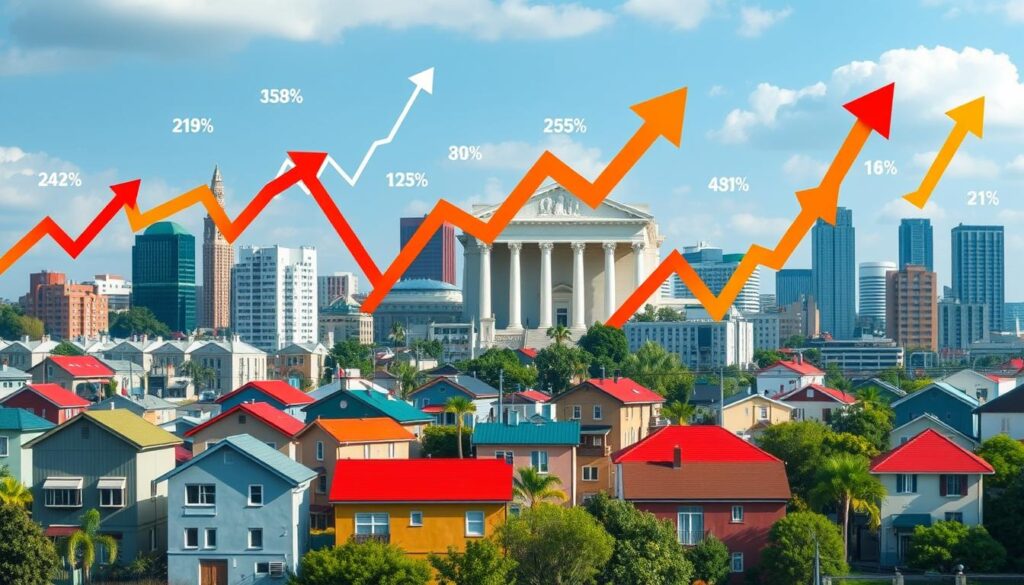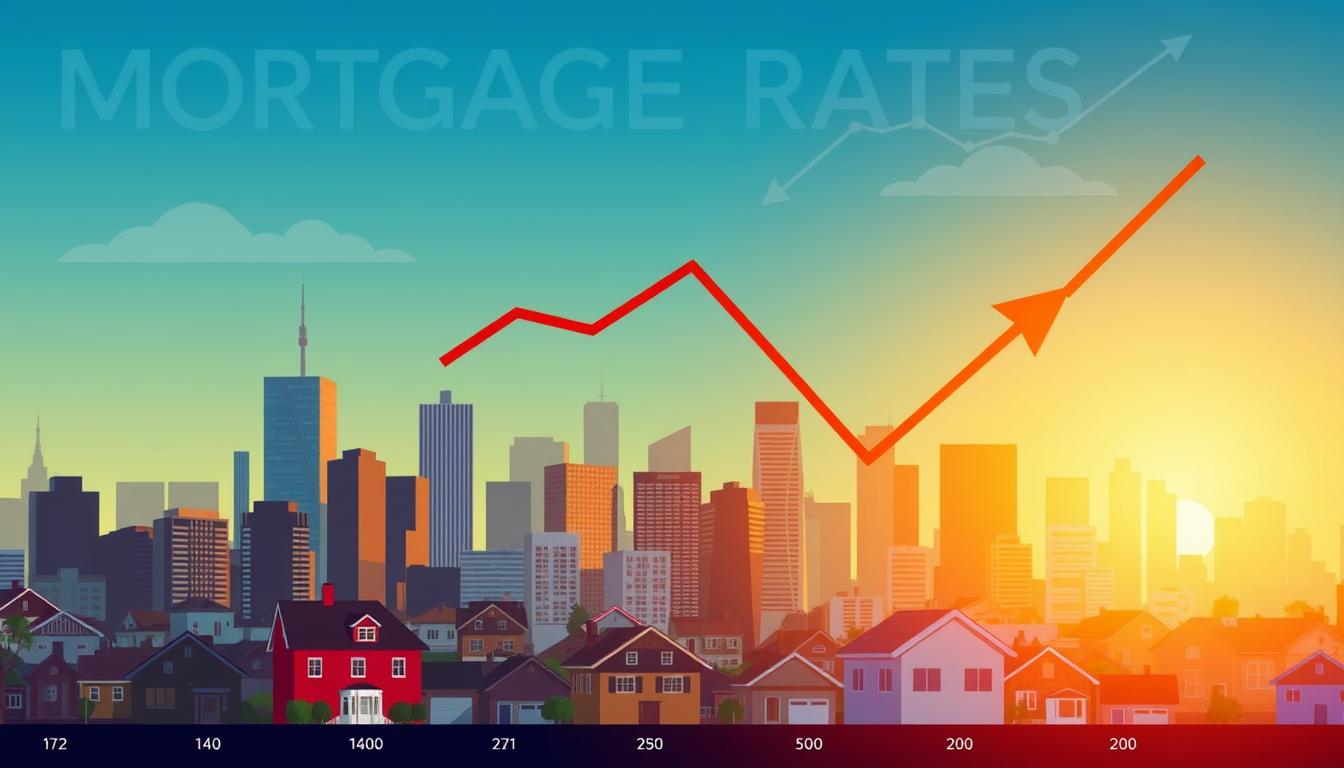Did you know that the average 30-year fixed mortgage rate skyrocketed to 7.79% in October 2023, a sharp contrast to the record low of just 2.65% in early 2021? This startling increase underscores how quickly the landscape of mortgage rates can change, making it essential for homebuyers to stay informed. As we delve into the mortgage rate trends, recent shifts in current mortgage rates are crucial for understanding how they impact the housing market and your buying decisions. With the complexities of housing market trends and the ever-widening array of mortgage options, having actionable homebuyers insights at your disposal can empower you to navigate this challenging environment effectively.
Understanding past and current mortgage rate behaviors is not just about numbers; it directly relates to how buyers can maximize their opportunities in an increasingly competitive market. Get ready to explore the fluctuating landscape of mortgage rates and gain valuable mortgage insights to aid your journey.
Key Takeaways
- Mortgage rates can fluctuate rapidly, affecting your purchasing power.
- Understanding trends in current mortgage rates is vital for making informed decisions.
- Historical low rates provide a benchmark for today’s rates, which are significantly higher.
- The housing market is influenced by a variety of factors, including economic stability and inventory levels.
- Homebuyers can benefit from knowing how to navigate these trends effectively.
Understanding Mortgage Rates
Understanding mortgage rates is vital for anyone considering purchasing a home. Mortgage rates represent the interest charged on loans taken out to buy properties. These rates can significantly affect monthly payments and the overall cost of homeownership. Various factors influence these rates, creating a dynamic lending environment.
What Are Mortgage Rates?
Mortgage rates refer to the interest applied to home loans, which fluctuate based on economic conditions and lender policies. Borrowers pay these rates over the term of the loan, typically 30 years for fixed-rate mortgages. Current trends indicate an average 30-year fixed mortgage rate at approximately 6.50%, while shorter-term loans, like the 15-year fixed mortgage, are around 5.84%.
How Mortgage Rates Are Determined
Multiple mortgage rate determinants exist, affecting how lenders set their rates. Lenders consider credit scores, down payment amounts, and loan types to assess borrower risk. This assessment helps in establishing personalized mortgage interest rates while reflecting the broader economic landscape. For instance, a stronger economy may result in higher rates, whereas a weaker economy could lead to lower rates.
The Role of the Federal Reserve
The Federal Reserve impact on mortgage rates cannot be overstated. When the Fed adjusts the federal funds rate, it directly affects borrowing costs for consumers and businesses alike. Typically, an increase in the federal funds rate leads to higher mortgage interest rates, making loans more expensive. Observations indicate mortgage rates have experienced significant fluctuations, peaking at 7.79% in October 2023. As we approach 2025, rates are projected to settle in the high 5% range, creating an environment where buyers may find opportunities for better deals.

| Loan Type | Interest Rate |
|---|---|
| 30-Year Fixed Mortgage | 6.50% |
| 15-Year Fixed Mortgage | 5.84% |
| 5/1 Adjustable Rate Mortgage (ARM) | 6.70% |
| 30-Year VA | 5.92% |
| Current Refinance Rate (30-Year Fixed) | 6.51% |
Current Trends in Mortgage Rates
Homebuyers today face a dynamic environment shaped by fluctuations in mortgage rates. A thorough understanding of historical mortgage rates can provide valuable insights into current mortgage rate trends. The journey from record lows to significant peaks illustrates the volatility of the market. Homebuyers must remain vigilant about these changing conditions to make informed decisions.
Historical Perspective
In recent years, mortgage rates have experienced dramatic swings. The average rate for a 30-year fixed mortgage plummeted to a record low of 2.65%, which sparked a surge in home purchases and refinances. Subsequently, rates soared to heights surpassing 7%, leaving many homebuyers feeling uncertain. This brief overview of historical mortgage rates highlights the inherent unpredictability in the market.
Recent Changes and Projections
Recent updates in the market forecast suggest that average mortgage rates may stabilize around 6.3% by 2025, with mild decreases anticipated over the next year. Such projections may not significantly benefit prospective buyers, as rising home prices often offset lower rates. A key factor for both buyers and sellers remains strategic planning amid the competitive landscape for desirable properties.

| Mortgage Type | Current Rate (%) | Historical Low (%) | Recent Projections (%) |
|---|---|---|---|
| 30-Year Fixed | 6.50 | 2.65 | 6.3 (by 2025) |
| 20-Year Fixed | 6.36 | 2.50 | 6.2 (by 2025) |
| 15-Year Fixed | 5.84 | 2.29 | 5.7 (by 2025) |
| 5/1 ARM | 6.70 | 3.25 | 6.5 (by 2025) |
| 7/1 ARM | 6.59 | 3.10 | 6.4 (by 2025) |
Factors Influencing Mortgage Rate Trends
Understanding the factors influencing mortgage rates is essential for potential homebuyers. Various economic indicators, such as unemployment rates and consumer spending, play a crucial role in shaping these rates. By monitoring these indicators, prospective buyers can gain valuable insights into the current mortgage landscape.
Economic Indicators to Watch
Key economic indicators often reflect the overall health of the economy. For instance:
- Unemployment rates can signal consumer confidence and spending power.
- Consumer spending trends influence demand for housing and, ultimately, mortgage rates.
- Inflation effects on mortgage rates are significant, as rising prices generally lead to increased borrowing costs.
The Impact of Inflation
Inflation tends to erode purchasing power, prompting lenders to adjust mortgage rates upwards to mitigate risk. As inflation rises, it creates uncertainty in financial markets, leading to potential increases in mortgage rates. Staying informed about inflation trends provides buyers with a broader understanding of potential rate changes.
The Role of Supply and Demand
The housing market supply and demand dynamics directly impact mortgage rates. As of October 2025, existing-home sales increased by 3.4%, marking a positive shift after a lengthy downturn. Current data shows approximately 1.37 million unsold homes, suggesting a 4.2-month supply at the present sales pace. A growing inventory, coupled with stabilizing mortgage rates, offers hope for a buyer’s market.
| Indicator | Current Value | Trend |
|---|---|---|
| Existing-Home Sales Rise | 3.4% (October 2025) | Positive Year-over-Year Increase |
| Unsold Homes Inventory | 1.37 Million | Increased 19.1% From Last Year |
| Median Home Price | $407,200 | 4.0% Increase Over Last Year |
| Total Housing Inventory | 1.37 Million Units | 0.7% Increase From September |

Tips for Homebuyers Navigating Mortgage Rates
Navigating the landscape of mortgage rates can seem daunting, but with the right strategies, homebuyers can make informed decisions that lead to significant savings. Understanding the importance of mortgage purchase timing is essential. Tracking market trends can help determine the optimal moment to enter the market, maximizing your financial advantage. For instance, when the Federal Reserve adjusts rates, as seen recently with a quarter percentage point reduction, it can create ideal conditions for buyers to finalize deals.
Timing Your Purchase
Homebuyers should stay vigilant with economic indicators that signal shifts in mortgage rates. An understanding of when to act can be the difference between a favorable rate and one that’s higher. Recent fluctuations, such as the Dow Jones Industrial Average experiencing a tumultuous week, demonstrate the volatility of financial markets. Timing your purchase when rates dip can lead to long-term benefits for your mortgage portfolio.
Comparing Lenders and Offers
Another vital strategy is to compare mortgage lenders and their offers effectively. Rates and terms can vary significantly between institutions, making it crucial to review multiple options. By doing thorough research and factoring in various lender offerings, homebuyers can find competitive rates that fit their financial situation. Remember, securing the best terms now may yield significant long-term savings.
Locking in Your Rate
Lastly, consider locking in mortgage rates once you identify a favorable lender. A rate lock can be essential, particularly in a fluctuating market where sudden increases can occur. This agreement secures your rate while your loan processes, providing peace of mind as you navigate the complexities of purchasing a home. These practical tips for homebuyers can make the mortgage process smoother and more rewarding.









